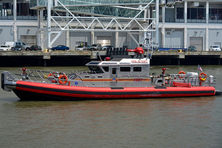THE PAID DEPARTMENT
20th Century Firefighting 1945–Present

RELATED ARTICLES: Laying the Groundwork Emergency Medical Services Special Operations Post 9/11 Diversity
Firefighting Meets the Modern Age
Advances in firefighting technology and equipment – from motorized apparatus to the Scott Air-Pak, Tower ladder, and the Super Pumper, were accompanied by reorganizations and additions to the Department – all to efficiently and effectively meet the growing challenges of fighting fires in the modern age.
Because of the size of the city, the number of people, and types of dangers, the FDNY continues to operate with the same military-like precision that General Shaler instituted when he was commissioner in the 1860s. Firefighting in the FDNY requires a careful orchestration of people and equipment from the dispatcher to the firehouses to the fireground. The job is assisted with communication devices, including a Critical Information Data System, cell phones and mobile data terminals, extensive training at the Fire Academy, and, ultimately, the reliability of fellow firefighters to perform their duties as a disciplined team.
As we progress into an ever-changing future, the FDNY continues to develop new ways to meet the new challenges – and opportunities – it faces.

During the tumultuous “War Years” in NYC, massive fires stretched the FDNY to its limits and caused it to respond in creative ways to the unprecedented workload
The “War Years”
In the years following WWII, the urban landscape was changing. The Department relaxed residency restrictions, allowing FDNY members to live outside the five boroughs. With the help of the highway system, firefighters were able to become commuters, rather than living in the city where they worked. The housing benefits of the GI Bill for veteran firefighters, and the prosperity of the 1950s, allowed firefighters to move to suburbia and buy their own homes.
The decades of the 1960s and 1970s, however, were not as prosperous for New York and poverty rates increased as the city underwent a fiscal crisis. Social unrest combined with a bad local economy led to what many refer to as the “war years.” Vacant buildings and decreasing property values, led to landlords setting fire to their properties in order to obtain insurance claims. Arson was also used as a political statement. Civil unrest, caused by the general political and economic climate, as well as specific events, such as Dr. King’s assassination in April of 1968, caused rioting in the streets of major U.S. cities. In New York, firefighters battled waves of arson and were attacked while riding on the outsides of their apparatus. The number of fires from 1960 to 1977 increased from 60,941 to 129, 619. False alarms also rose, going from 89,432 in 1960 to 263, 659 in 1970.
In response to these tumultuous times, the Department instituted major changes. In 1967, apparatus were enclosed so that all firefighters rode inside the cab. In 1969, the FDNY formed new companies to relieve engine and ladder companies in high workload areas. In an effort to decrease the number of false alarms, the first Emergency Response System fire and police alarm boxes were installed in 1970, which required voice communication between the emergency dispatcher and the person reporting the alarm.










